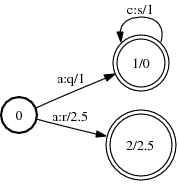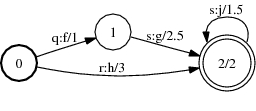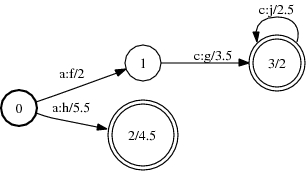Compose
Description
This operation computes the composition of two transducers. IfA transduces string x to y with weight a and B
transduces y to z with weight b, then their composition transduces
string x to z with weight a ⊗ b.
The output labels of the first transducer or the input labels of the second transducer must be sorted (or the FSTs otherwise support appropriate
matchers).
The weights need to form a commutative semiring (valid for TropicalWeight and LogWeight for instance).
Versions of this operation (not all shown here) accept options that allow choosing the matcher, composition filter, state table and, when delayed, the caching behavior used by composition.
Usage
Examples
A:

B:

A o B:

Compose(A, B, &C); ComposeFst<Arc>(A, B); fstcompose a.fst b.fst out.fst
Complexity
Assuming the first FST is unsorted and the second is sorted:Compose: - Time: O(V1 V2 D1 (log D2 + M2))
- Space: O(V1 V2 D1 M2)
ComposeFst: - TIme: O(v1 v2 d1 (log d2 + m2)),
- Space: O(v1 v2)
Caveats
Compose and fstcompose trim their output, ComposeFst does not (since it is a delayed operation).
The efficiency of composition can be strongly affected by several factors: - the choice of which transducer is sorted
- prefer sorting the FST that has the greater average out-degree
- sorting both transducers allows composition to automatically select the best transducer to match against (per state pair)
- note stored sort properties of the FSTs are first checked in constant time followed by the minimum number of linear-time sort tests necessary to discover one sorted FST; thus composition may be unaware that both FSTs are sorted when those properties are not stored.
- the amount of non-determinism
- the presence and location of epsilon transitions - avoid epsilon transitions on the output side of the first transducer or the input side of the second transducer or prefer placing them later in a path since they delay matching and can introduce non-coaccessible states and transitions
See Also
Composition Filters, Matchers, State Tables| I | Attachment | History | Action | Size | Date | Who | Comment |
|---|---|---|---|---|---|---|---|
| |
compose1.jpg | r2 r1 | manage | 11.7 K | 2007-06-30 - 21:47 | MichaelRiley | |
| |
compose2.jpg | r7 r6 r5 r4 r3 | manage | 11.2 K | 2007-06-30 - 21:47 | MichaelRiley | |
| |
compose3.jpg | r6 r5 r4 r3 r2 | manage | 14.8 K | 2007-06-30 - 21:47 | MichaelRiley |
Topic revision: r24 - 2018-04-27 - MichaelRiley
Ideas, requests, problems regarding TWiki? Send feedback


